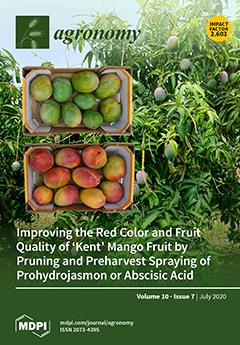Salinity stress is one of the most problematic constraints to significantly reduce rice productivity. The
Saltol QTL (quantitative trait locus) has been known as one among many principal genes/QTLs responsible for salinity tolerance in rice. However, the introgression of the
Saltol QTL from the donor (male) into the recipient (female) cultivars induces great recessions from the progeny generation, which results in heavy fieldwork and greater cost and time required for breeding. In this study, the F
1 generation of the cross TBR1 (female cultivar, salinity tolerant) × KD18 (male cultivar, salinity susceptible) was preliminarily treated with N-methyl-N-nitrosourea (MNU) to induce the mutants M
1. Results on physiological traits show that all the M
2 (self-pollinated from M1) and M
3 (self-pollinated from M2) individuals obtain salinity tolerant levels as the recurrent TBR1. Twelve SSR (simple sequence repeat) markers involved in the
Saltol QTL (RM493, RM562, RM10694, RM10720, RM10793, RM10852, RM13197, RM201, RM149, RM508, RM587, and RM589) and other markers related to yield-contributing traits and disease resistance, as well as water and nitrogen use, have efficacy that is polymorphic. The phenotype and genotype analyses indicate that the salinity tolerant
Saltol QTL, growth parameter, grain yield and quality, pest resistance, water and nitrogen use efficacy, and beneficial phytochemicals including antioxidants, momilactone A (MA) and momilactone B (MB) are uniparentally inherited from the recurrent (female) TBR1 cultivar and stabilized in the M
2 and M
3 generations. Further MNU applications should be examined to induce the uniparental inheritance of other salinity tolerant genes such as
OsCPK17,
OsRMC,
OsNHX1,
OsHKT1;5 to target rice cultivars. However, the mechanism of inducing this novel uniparental inheritance for salinity tolerance by MNU application needs elaboration.
Full article





